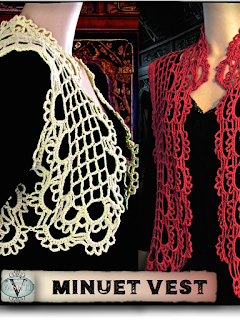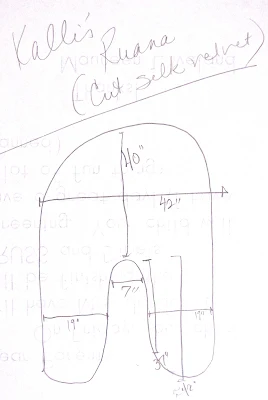Tomorrow I teach a class in Sarasota, Florida on crocheting jewelry--a.k.a. "jewellry," "jewerly," "jewellery" and other favorite spellings :-)
For all of my crochet classes I include a page of resources in the handouts (helpful links, books that I recommend, etc.). However, my jewelry class handout is already several pages long due to so many close-up photos.
The best class handout for jewelry crochet needs to show several close ups of those precious little details and special crochet stitches that make crochet bracelets, necklaces, rings, brooches, and earrings so fun to make and give as gifts. What to do?
Today I hit on a great idea: I'm going to post the Crochet Jewelry Class Resources list HERE IN THIS BLOG POST! See below. Cool idea, right? This way they're clickable URLs. Also, crocheters anywhere can refer to it, even if you can't attend the Sarasota crochet class tomorrow. (If you think you can attend, it will be held from 1 - 4 pm on March 24, 2012 at an easy-to-find yarn shop on South Tamiami Trail called A Good Yarn.)
[Hi, this is FutureVashti from 2018. See the class resources for all of my classes at my new blog!]
Crochet Jewelry Class: Resources
All class content ©Vashti Braha. Resources recommended for a three-hour class held March 24, 2012 at A Good Yarn yarn shop in Sarasota, Florida USA; and taught nationally at the CGOA Chain Link conference in Reno Nevada in 2012. Please see this blog post also for more crochet jewellery resources I like.
Crochet Inspirations Newsletter Topics:
Blogged:
Books I've consulted. The most recently published are listed first with short descriptions of the books I recommend and use the most & why: Click on a title to go to the book's Amazon page for more information.
2010. Ann Benson, Tapestry Bead Crochet: Projects and Techniques. Lark Crafts. This is my favorite source for this specific type of bead crochet. Not only is it very inspirational for me, it also is written by someone who is obviously a good teacher. She even created many of the excellent illustrations. Author's site: beadseast.com
2009. Pat Harste, Hooked on Jewelry. Sixth and Spring Books. This is my resource for how to use stylish and traditional metal jewelry findings with fiber crochet jewelry designs, and why I might want to. I usually prefer to crochet them, but this author uses them in such an inspiring way. I also love the way the book makes it clear and fun to learn about the jewelry tools and supplies. Author's Ravelry page.
2007. Waejong Kim and Anna Pulvermakher, Crochet Jewelry. Interweave Press. This book combines a creative and exciting array of jewelry designs by several crochet designers. I use it as a resource of other designers' "lab notes" and results crocheting jewelry with eclectic materials. (Scroll halfway down through my other blog post for more on this.)
 |
Size #20 crochet thread pendant cords;
some are published in Jewelry With a Hook. |
2007. Terry Taylor, Jewelry With a Hook. Lark. Like the Waejong Kim book above, this book is a wide-ranging compilation of creative jewelry crochet designs and materials. So I use it foremost as a source for "lab notes" (how other designers combined eclectic materials). In addition, I like the "Crochet Basics" section at the back of the book. (I would still value this book the same way even if it didn't include four designs of my own.)
2006. Carol Ann Ventura, Bead and Felted Tapestry Crochet. Self published, ISBN 978-09721253-2-1. Carol Ventura is the queen of tapestry crochet in crochet circles, and her self-published books are the next best thing to taking her classes at the CGOA conferences. The one I have includes sections specially for left handers, and for working flat vs. in the round. Author's site: tapestrycrochet.com
2005. Adele Rogers Recklies, Bead Crochet Snakes: History and Technique. This book fascinates me. I had no idea of the history and art of bead crochet ropes as snakes. Beautiful examples. Self published: Reckless Beading Press, ISBN 978-0-9791649-0-3. Author's site: beadcrochetsnakes.com
2004. Bethany Barry, Bead Crochet. Interweave Press. This book used to strike me as odd (like the Neiman book below), but not anymore, now that I understand the differences between beaded jewelry that happens to be crocheted, vs. crochet that is used for jewelry and that may include some beads. In other words, jewellery crocheting lies at an intersection of two industries: the crochet ('handknitting') yarn industry, and that of the beaders and other non-crochet jewelry making hobbies, like wirework/wire-wrapping, micro-macrame, etc. The basic materials, tools, and vocabulary can be very different. It's more obvious when you visit a bead shop and then a yarn shop; or the crochet aisle, then the jewelry aisle in a craft store! Author's site: bethanybarry.com

2004. Lily Chin, Knit and Crochet with Beads. Interweave Press. A masterful reference especially for exploring the choices crocheters and knitters have when incorporating beads into several kinds of projects besides jewelry. Author's site: lilychinsignaturecollection.com
2004. Sherri Haab, Designer Style Jewelry. Watson-Guptill. I enjoy having this one on hand for the techniques I hope to try someday, for example, using resin to create pendants and charms, which would be easy to combine with crochet; or updated possibilities with that "ShrinkyDink®" material I LOVED as a kid. So it has a great list of suppliers at the back of the book.
2004. Mary Libby Neiman, Bead Crochet Basics. Design Originals booklet, ISBN 978-1-5742153-4-2. This slim book is a good reference for me because I'm a newbie when it comes to a particular type of crochet jewelry: "beaded ropes" a.k.a. "tubular bead crochet." The idea is to see all seed beads, no crochet stitches. (Also see Ann Benson's Tapestry Bead Crochet, above.) Like I described Bethany Barry's Bead Crochet book above, this one used to confuse me as a crocheter. Part of the confusion is that both titles use "bead crochet" in a much more limited way than I would with the crocheters I know. Both also seem to be written by and for a general beading/bead shop audience rather than a crocheting audience. Author's site: d-originals.com
1997. Lydia F Borin, Beadwrangler’s Hands On Crochet with Beads and Fibers. I was happy when a copy of this book fell into my lap because I'd tried to locate a copy for several years, after learning so much about the topic at the author's site, below! Self published: Lyden Enterprises, ISBN 1-891302-01-9. Author's site: beadwrangler.com











































